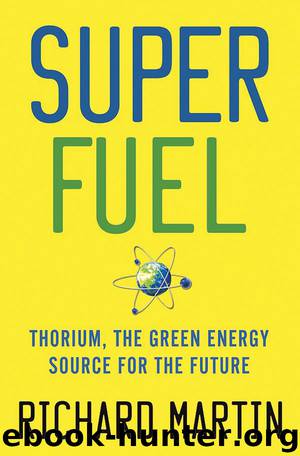SuperFuel: Thorium, the Green Energy Source for the Future by Richard Martin

Author:Richard Martin [Martin, Richard]
Language: eng
Format: epub
Publisher: St. Martin's Press
Published: 0101-01-01T00:00:00+00:00
SEVEN
THE ASIAN NUCLEAR POWER RACE
The island city of Mumbai, India’s cultural and business center, droops like an elephant’s trunk into the Arabian Sea. The Trombay district in the northeast of the city occupies the elephant’s forehead. Inhabited for centuries by fishermen who plied Thane Creek, which forms Mumbai’s eastern boundary, Trombay was once an island itself, but successive reclamation projects have joined it to the main mass of the city. Nevertheless it’s still a separate place, quieter and less chaotic than Mumbai proper. It’s known for the Palipada masjid, or mosque, one of the oldest on the Indian subcontinent, and for several seventeenth-century Portuguese churches, built by the earliest European explorers, that now lie in ruins. Trombay has one of India’s most diverse population mixes, Tamils and Maharashtrians living in relatively harmonious proximity to Punjabis, Sindhis, and Keralites.
It’s also known for its warehouses and industrial complexes, and for the foremost scientific institution in India: the Bhabha Atomic Research Centre (BARC), the heart of India’s ambitious thorium power program.
India is surely the only nation in the world to place a nuclear research center with at least seven operating reactors on the edge of one of its most populous cities. Mumbai has a population of almost 21 million, a great many of whom live within a dozen or so kilometers of the Bhabha Centre. It’s as if Los Alamos were located in Brooklyn. There has never been a serious accident at Bhabha. If there ever were, it would make Chernobyl look like a brushfire. Even the Soviets had the sense to locate their major reactor complexes far from urban centers.
Surrounded by circular gardens and artificial ponds, with towering smokestacks and a huge containment dome, BARC bears a strong resemblance in silhouette to a citadel of medieval Islam, dominated by domed mosques and towers for the muezzin who call the faithful to prayer. Bhabha, though, is a decidedly secular temple. The thorium-powered second nuclear era that Alvin Weinberg prophesied is being forged here. With a population of 1.21 billion that adds another 20 million or so souls each year, and an annual economic growth rate of about 8.5 percent, India is one of the most energy-hungry nations on Earth. Today India gets less than 3 percent of its electricity from nuclear plants, relying heavily on coal and crude oil imports to fuel its economic boom. The country has 27 nuclear reactors today, generating about 4.7 gigawatts. The government of Prime Minister Manhoman Singh has said it will build up to 62 reactors by 2025, generating about 63 gigawatts and raising nuclear energy’s share of the country’s electricity production to 25 percent. And most of those reactors will be advanced heavy-water converter reactors, running on an inexhaustible supply of thorium.
India, which has either the world’s largest or second-largest reserves of thorium (in competition with Australia, depending on who’s counting and how recently the calculation was made), is the only country in the world with a detailed, funded, government-approved plan to base its nuclear power industry on thorium-fueled reactors.
Download
This site does not store any files on its server. We only index and link to content provided by other sites. Please contact the content providers to delete copyright contents if any and email us, we'll remove relevant links or contents immediately.
| Concrete | Extraction & Processing |
| Fracture Mechanics | Materials Science |
| Metallurgy | Polymers & Textiles |
| Strength of Materials | Testing |
Whiskies Galore by Ian Buxton(40326)
Introduction to Aircraft Design (Cambridge Aerospace Series) by John P. Fielding(32337)
Small Unmanned Fixed-wing Aircraft Design by Andrew J. Keane Andras Sobester James P. Scanlan & András Sóbester & James P. Scanlan(32141)
Craft Beer for the Homebrewer by Michael Agnew(17445)
Turbulence by E. J. Noyes(7037)
The Complete Stick Figure Physics Tutorials by Allen Sarah(6637)
Kaplan MCAT General Chemistry Review by Kaplan(6053)
The Thirst by Nesbo Jo(5782)
Bad Blood by John Carreyrou(5766)
Learning SQL by Alan Beaulieu(5407)
Weapons of Math Destruction by Cathy O'Neil(5034)
Man-made Catastrophes and Risk Information Concealment by Dmitry Chernov & Didier Sornette(4733)
iGen by Jean M. Twenge(4701)
Digital Minimalism by Cal Newport;(4529)
Life 3.0: Being Human in the Age of Artificial Intelligence by Tegmark Max(4501)
Audition by Ryu Murakami(4097)
1,001 ASVAB Practice Questions For Dummies by Powers Rod(4036)
Electronic Devices & Circuits by Jacob Millman & Christos C. Halkias(4024)
Pale Blue Dot by Carl Sagan(4001)
